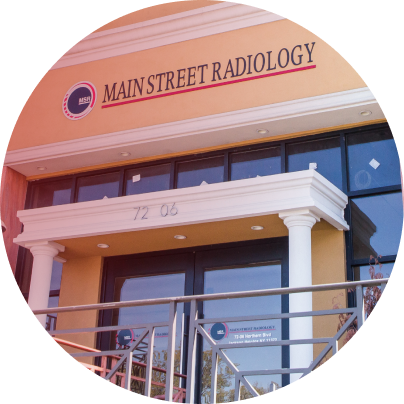Non-Invasive Procedure Measures Many Body Functions
Already Scheduled for a PET Or CT Scan?
Already Scheduled for a PET Or CT Scan?
Learn how to prep for your medical procedure.
Leading The Way in Diagnostic Imaging
Main Street Radiology is proud to have been the first radiology office in Queens to install a PET scanner.
- Since October 2002, our radiologists have been successful in obtaining a whole-body image to help diagnose diseases and other conditions.
- A PET scan is typically an outpatient procedure. You can generally resume normal activities immediately after the test.
The PET/CT Procedure
A special type of non-invasive technology can be used to check for diseases in your body, including several different types of cancers, as well as indicators of Alzheimer's and Parkinson's disease. The test, called a positron emission tomography (PET) scan, can also detect heart abnormalities.
How Does It Work?
- A special dye containing radioactive tracers is swallowed, inhaled, or injected into the arm, depending on what body part is being examined.
- The tracers collect in places with higher chemical activity. That's important because certain body tissue, and certain diseases, have a higher level of chemical activity.
Precise Disease Detection:
- When detected by a PET scanner, the tracers help your doctor to see how well organs and tissues are working.
- Areas with disease show up as bright spots on the PET scan. The scans can show problems at the cellular level, giving your doctor the best view of complex diseases.
- They also measure overall metabolic functions, such as blood flow, oxygen use, and much more.
Patient Preparation:
- For 4 hours before the exam, do not eat or drink. (However, you may drink as much water as you like).
- If you are a diabetic, you must abstain from any diabetic medications on the day of the exam.
- You may take any other prescribed medications, including hypertension medication and seizure medication.
- You must limit your exercise for at least 24 hours prior to the exam.
- If you are, or think you may be pregnant please let us know as PET-CT is not generally performed on pregnant women.
What To Bring and Wear:
- Bring your previous PET-CT scans, CT Scans, MRI films, and/or chest X-rays with you.
- Bring your insurance cards, prescription and photo ID.
- Wear warm, comfortable clothes as the scanner room is cool.
Arrive On Time:
- You should arrive at least 15 minutes before your scheduled appointment time.
- If you must cancel or reschedule, you need to do so at least 24 hours before your appointment, so that the injection dose for your exam may be cancelled.
Your PET-CT Scan:
- After registering, you will go to a preparation area where a PET-CT technologist will insert a small IV into your arm.
- A small amount of the tracer, fluorodeoxyglucose or FDG, will be injected through the IV.
- You will rest for 45 to 60 minutes while the FDG circulates.
- Your scan will then take approximately 15 minutes.
Who Should Be Tested?
- About two million PET scans are conducted in the U.S. annually. The Center for Medicare and Medicaid Services (CMS) has announced that the following indications may be reimbursed. Most insurance companies also reimburse patients for PET scans.
- Colorectal Carcinoma
- Breast Cancer
- Solitary Pulmonary Nodule
- Lymphoma
- Esophageal Carcinoma
- Non-small Cell Lung Carcinoma
- Melanoma
- Thyroid Carcinoma
- Head and Neck Carcinoma
- Alzheimer’s Disease
- Refractory Seizure
- DaT Scan for Parkinson's Disease
Share your experience
Your feedback is very important to us! We encourage you to share your past experience with Main Street Radiology.

Get to know Main Street Radiology in Queens
We have the gold seal of accreditation by the American College of Radiology with a long history of providing quality radiology care.
